PDF Attached
CBOT
agriculture markets rallied in part to positive sign the US economy will gradually recover, poor SA weather, and rumors of US export demand. US equities rebounded to close sharply higher and WTI crude oil made new contract highs (April added about $2.45).
US jobs were better than expected (we noted disappointing in our am note). Most jobs were added in the bar and restaurant industries, a good sign of the economy reopening. Unemployment stands at 6.2%.


World
Weather Inc.
CHANGES
OVERNIGHT
- Rain
fell overnight from eastern Colorado into Kansas from the northwest into south-central parts of the state as well as in north-central Oklahoma - The
event occurred as expected with moisture totals of 0.20 to 0.65 inch common and Goodland, Kansas (in the northwest) reporting 0.87 inch - Argentina’s
forecast was wetter in the far southern part of the nation March 12-13 relative to the previous model run and a small part of the north was also a little wetter - Northern
Argentina was also wetter March 16-18 - Central
Argentina was still advertised with restricted rainfall, although some showers and thunderstorms will occur form Cordoba into central Buenos Aires Sunday into Monday that might help slow some of the region’s drying - No
serious changes were noted in Brazil’s outlook overnight - U.S.
weather was a little wetter from eastern Kansas to Ohio March 11-12 and central Texas to Southern Illinois precipitation was reduced during that same period of time.
- Model
divergence remains for the southern Plains - The
GFS model brought in significant moisture to the region March 18-19, but this event was likely overdone - The
European model run suggested greater precipitation for the southern Plains March 13-14
- This
event does not look like it will verify either - Not
much change of significance for other areas in the world
WEATHER
TO WATCH THIS WEEKEND
- Argentina’s
rainfall outlook is not very good and many areas in the nation will experience net drying over the coming week, despite some periodic showers of varying significance - Most
of the precipitation will not counter evaporation for a while - World
Weather, Inc. sees some changes in the upper air wind pattern evolving in the second week of the forecast that may help to bring a little better opportunity for rain periodically - But
confidence is still low on how much relief might occur - Crop
stress will remain a serious concern for many summer crops in Argentina until a generalized soaking rain evolves. Pockets of improvement may occur if the rain advertised in the next two weeks verifies, but some areas will remain too dry to support the best
yields and crop quality. - Temperatures
will be very warm to hot which may limit the benefit of lighter showers that occur over the next seven days.
- Some
cooling is expected March 12-18 - Brazil’s
weather has not changed overnight and for the next two weeks most of the nation will be impacted by alternating periods of rain and sunshine - The
moisture will be mostly near normal except in the northeast where drier than usual conditions are expected - A
few locations in southern Rio Grande do Sul may also receive a more limited amount of rain - Fieldwork
will advance around the expected shower activity, but there will be enough drier days for favorable progress to be made - U.S.
hard red winter wheat areas will trend drier after this morning’s rain ends - Southwestern
U.S. Plains may continue missing rain events for a while - Rain
may be possible again in the second week of the outlook, but confidence is low - U.S.
central Plains wheat will benefit from the next ten days of periodic moisture and sunshine, but there will still be need for more precipitation especially in the southwest where rainfall will likely be lightest - Frequent
rain and mild temperatures are needed to induce new tillering and to stimulate some crop recovery and improvement in production potentials after dryness last autumn and the bitter cold event of February - Southeastern
parts of the U.S. northern Plains will have a good opportunity for some needed moisture Monday night into Wednesday morning - Moisture
totals will vary from 0.05 to 0.50 inch - Minnesota
and eastern South Dakota will likely be wettest - Drought
to the west will not likely be impacted - Temperatures
will be unusually warm in these areas through the weekend with extreme highs in the 60s and 70s expected Saturday - Much
of the U.S. Midwest will be dry into early next week and what little moisture occurs in the north is not likely to create a problem as the region’s snow cover continues to melt - Central
parts of the Midwest will trend wetter during the second half of next week with another storm system in the second week of the outlook - U.S.
southeastern states will see less frequent and less significant rain in the coming ten days resulting in needed drying and some spring planting - Unseasonably
warm temperatures in the central U.S. will send temperatures into the 60s and lower 70s Fahrenheit this weekend as far north as Montana, southwestern North Dakota and South Dakota - Normal
highs in the northern Plains should be in the 30s and 40s followed by lows in the teens and 20s - The
warmup in the northern Plains should set the stage for some needed moisture to fall when colder weather returns next week - Drought
remains a serious concern across the Dakotas, eastern Montana and areas north into the Canada Prairies - Temperatures
in the 50s and lower 60s might also reach into southern Saskatchewan and southern Alberta, Canada
- Unusual
warmth in the central Plains and light precipitation overnight may also stimulate some new wheat development
- Soil
temperatures are already rising, and some greening has begun in the southern Plains - Southern
U.S. spring planting is getting off to a slow start in southern Texas due to dryness in unirrigated areas, but it has begun - Slow
planting has also occurred near the central Gulf of Mexico coast from Louisiana to northern Florida and Georgia because of wet fields, but some fieldwork has likely evolved recently
- Improving
weather in the lower Delta and southeastern states in this coming week will lead to improved corn and rice planting conditions in time. - Canada’s
central, eastern and southwestern Prairies will remain drier than usual through the next ten days
- Precipitation
elsewhere is expected to be infrequent and light limiting the potential for increasing soil moisture - Temperatures
will be near to above average - Southeast
Canada will experience a seasonable mix of precipitation and sunshine with temperatures a little cooler than usual - North
Africa rainfall will improve over this coming week with many areas from northern Morocco through northern Tunisia getting rain at one time or another lifting topsoil moisture for future crop development - Winter
crops are semi-dormant, but expected to resume development soon - Ivory
Coast, Ghana, Benin and southern Nigeria will experience a boost in rainfall for a while late this week into next week favoring coffee and cocoa flowering
- East-central
Africa rainfall will continue greatest in Tanzania this week and probably next week, as well - A
more erratic and light precipitation pattern is expected elsewhere with net drying in Ethiopia, northern Uganda and in a few southwestern Kenya locations - South
Africa will experience an erratic rainfall pattern through the next two weeks with temperatures mostly in a seasonable range with a slight warmer bias in the west - Showers
will be greatest in Natal and eastern portions of both Mpumalanga and Limpopo - Net
drying will occur in most other areas - Summer
crop conditions will remain favorably rated, although there will be a growing need for showers by mid-March - India
was mostly dry Thursday - Very
little rainfall is expected over the next week to ten days and temperatures will be seasonably warm - Showers
will occur in the far north, extreme south and far east - Some
mild crop stress is expected resulting in some minor yield loss - Rain
is needed to support the best potential yields before filling ends this month - China
weather over the coming week will include seasonably warm temperatures and near to above average precipitation in the south - The
greatest precipitation relative to normal will be in the Yangtze River Basin and areas to the south - Rainfall
near and south of the Yangtze River will vary from 1.00 to more than 5.00 inches except in the coastal provinces where amounts will be less than 1.00 inch - Local
flooding is possible - Yunnan
will remain dry and produces 3% of the corn crop and quite a bit of rice and sugarcane - Australia
weather in the coming week is expected to bring back scattered showers and thunderstorms to northeastern New South Wales and southern Queensland this weekend into next week - The
precipitation will be good for late season crops and for improving topsoil moisture for autumn planting - Early
maturing cotton might not welcome the precipitation - Mexico
drought conditions are still prevailing, although the impact on winter crops is low due to irrigation - Water
supply is low in some areas and a notable improvement in rainfall is needed, but not very likely - Dryland
winter crops are stressed and will yield poorly - Freeze
damage is common in northern parts of the nation due to a couple of cold surges this winter - Rain
in the coming week will be mostly confined to the east coast and temperatures will be seasonable with a slight warmer bias in the driest areas - Central
America precipitation will continue greatest along the Caribbean Coast and in Guatemala while the Pacific Coast is relatively dry - Southeast
Asia rainfall will occur relatively normally over the next two weeks - Mainland
areas will experience few showers periodically in the next week to ten days - The
resulting rainfall will be sporadic and light with net drying probably continuing in many areas for a while longer - Philippines
rainfall will be scattered and mostly light to moderate until late next week when a boost in precipitation is expected - Indonesia
and Malaysia weather during the next two weeks will bring rain to most crop areas maintaining a very good outlook for crop development - A
boost in precipitation is expected and will be welcome - Sumatra,
Peninsular Malaysia and western parts of Borneo have been drying out recently and greater rain is needed especially in Peninsular Malaysia - New
Zealand weather over the next ten days will include a mix of sunshine and rain while temperatures are a little cooler than usual
- The
nation’s soil moisture has drifted below average especially in the north - Southern
Oscillation Index has been falling and was at +8.29 this morning. The index is expected to continue to fall notably over the next several days - Warming
in Europe and the western CIS has been melting some snow - Snow-free
conditions are present today in Russia’s Southern Region, much of Ukraine and in many areas across Europe to the west of Ukraine and eastern Poland
- There
is no threatening cold in any winter crop region for the next ten days - Europe
weather will be tranquil over the coming week with only brief periods of light precipitation and temperatures close to normal - A
boost in precipitation is expected March 11-17 - Western
CIS temperatures will be seasonable with a slight warmer bias this week in the south and while a little cooler than usual in the north - Precipitation
will remain periodic keeping the region plenty moist in snow free areas and some significant runoff is expected in areas warm enough for melting snow
- Cooling
next week will bring some threatening cold air into the western CIS, but snow cover will adequately protect most crops
Source:
World Weather Inc.
Bloomberg
Ag Calendar
Sunday,
March 7:
- China
National People’s Congress in Beijing - China
customs to publish trade data, including import numbers for soy, edible oils, meat and rubber
Monday,
March 8:
- USDA
Export Inspections – corn, soybeans, wheat, 11am - EU
weekly grain, oilseed import and export data - China
National People’s Congress in Beijing - Ivory
Coast cocoa arrivals - HOLIDAY:
Russia - EARNINGS:
Marfrig
Tuesday,
March 9:
- USDA’s
monthly World Agricultural Supply and Demand (WASDE) report, noon - China
National People’s Congress in Beijing
Wednesday,
March 10:
- EIA
weekly U.S. ethanol inventories, production - Malaysian
Palm Oil Board data on February palm oil end-stockpiles, output, exports - China
National People’s Congress in Beijing - Malaysia’s
March 1-10 palm oil export data - ISO
sugar conference - FranceAgriMer
monthly grains report
Thursday,
March 11:
- USDA
weekly crop net-export sales for corn, soybeans, wheat, cotton, pork, beef, 8:30am - Port
of Rouen data on French grain exports - China
National People’s Congress in Beijing - New
Zealand Food Prices - Conab’s
data on yield, area and output of corn and soybeans in Brazil - HOLIDAY:
India, Indonesia
Friday,
March 12:
- ICE
Futures Europe weekly commitments of traders report (6:30pm London) - CFTC
commitments of traders weekly report on positions for various U.S. futures and options, 3:30pm - FranceAgriMer
weekly update on crop conditions
Source:
Bloomberg and FI

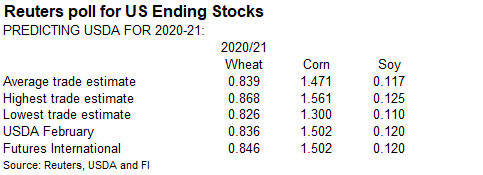
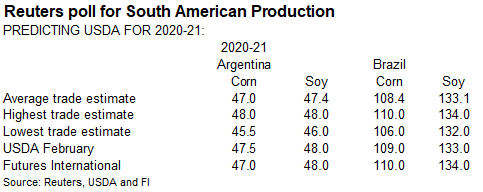
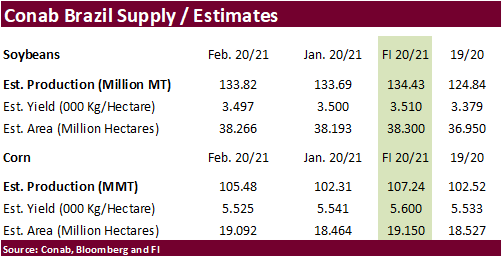
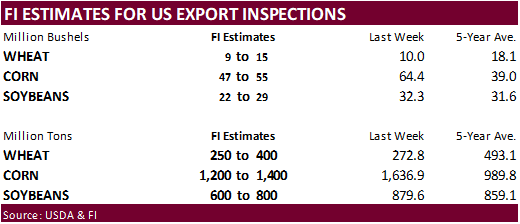
CFTC
Commitment of Traders



SUPPLEMENTAL
Non-Comm Indexes Comm
Net Chg Net Chg Net Chg
Corn
348,615 -24,212 406,940 811 -744,997 17,850
Soybeans
126,532 -25,259 167,637 2,976 -288,118 19,482
Soyoil
78,735 -2,113 126,140 -3,068 -226,378 4,916
CBOT
wheat 413 5,301 156,286 -318 -142,653 -3,913
KCBT
wheat 32,695 3,691 69,192 -965 -96,775 4,930
FUTURES
+ OPTS Managed Swaps Producer
Net Chg Net Chg Net Chg
Corn
348,546 -12,605 263,609 3,677 -729,567 18,654
Soybeans
155,561 -16,803 91,099 14,753 -273,369 9,091
Soymeal
65,424 -4,063 69,673 -1,054 -182,079 6,231
Soyoil
108,081 -4,564 92,538 -2,233 -239,062 5,609
CBOT
wheat 31,803 4,893 93,392 2,511 -121,574 -3,928
KCBT
wheat 51,724 -1,484 42,173 -380 -88,975 5,173
MGEX
wheat 14,101 1,948 4,192 711 -25,511 -3,549
Total
wheat 97,628 5,357 139,757 2,842 -236,060 -2,304
Live
cattle 80,570 -7,594 84,277 561 -170,476 5,555
Feeder
cattle 1,164 -570 7,692 -300 -1,988 235
Lean
hogs 74,133 1,352 55,032 -147 -128,516 -3,746
Source:
Reuters, CFTC and FI

US
Change In Nonfarm Payrolls Feb: 379K (est 198K; prevR 166K; prev 49K)
US
Unemployment Rate Feb: 6.2% (est 6.3%; prev 6.3%)
US
Average Hourly Earnings (M/M) Feb: 0.2% (est 0.2%; prevR 0.1%; prev 0.2%)
US
Average Hourly Earnings (Y/Y) Feb: 5.3% (est 5.3%; prevR 5.3%; prev 5.4%)
US
Change In Private Payrolls Feb: 465K (est 195K; prevR 90K; prev 6K)
US
Change In Manufacturing Payrolls Feb: 21K (est 15K; prevR -14K; prev -10K)
US
Average Weekly Hourly All Employees Feb: 34.6 (est 34.9; prevR 34.9; prev 35.0)
US
Labour Force Participation Rate Feb: 61.4% (est 61.4%; prev 61.4%)
US
Underemployment Rate Feb: 11.1% (prev 11.1%)
US
Trade Balance (USD) Jan: -68.2B (est -67.5B; prevR -67.0B; prev -66.6B)
Canadian
International Merchandise Trade Jan: 1.41B (est -1.4B; prev -1.67B)
Corn
- Corn
futures ended the week on a high note on US corn export chatter, Brazilian production concerns, Algeria buying 30,000 tons of corn, and WTI crude oil establishing new contract highs. May corn saw some resistance at its 20-day MA. Talk of China pig crop rebound
may also supported US corn futures. We picked up Brazil and China are close to an agreement on phytosanitary certificates for corn, and China may have recently bought Brazilian corn. This was on top of rumors the US could see a large sale corn sales announcement
on Monday. We already look for corn inspections north of 1.2 million tons to be reported by USDA midmorning Monday. Fresh US corn sales commitments, however, could provide additional support to CBOT futures next week. 89.5% of USDA’s corn export projection
is already sold, highest for this time of year since at least 2001 in our history.
- China
latest five-year plan promotes agriculture food security. China plans to raise the minimum purchase price for wheat and rice and expand corn planting. The lowered support prices for most commodities in 2018 due to high inventories. For wheat this would
be the first increase since 2014. - Meanwhile,
we are hearing its “a mess” for central and northern Brazil producers for collecting soybeans and plating second crop corn, bias Mato Grosso.
- Funds
were net buyers of 33,000 corn contracts on the session. - Vietnam
and other countries are relaxing on German pork import bans after ASF was discovered in wild boar last year.
- (Reuters)
– China’s first hog breeding exchange traded fund (ETF) makes its debut on the Shenzhen Stock Exchange on Friday, the first of three tied to the country’s booming pork sector that is rebuilding after African swine fever decimated herds in 2018.
Export
developments.
- Algeria
bought about 30,000 tons of corn, optional origin, at $289/ton to $293/ton c&f, for shipment by April 15.
EIA:
Cold weather brings near record-high natural gas spot prices
https://www.eia.gov/todayinenergy/detail.php?id=47016&src=email
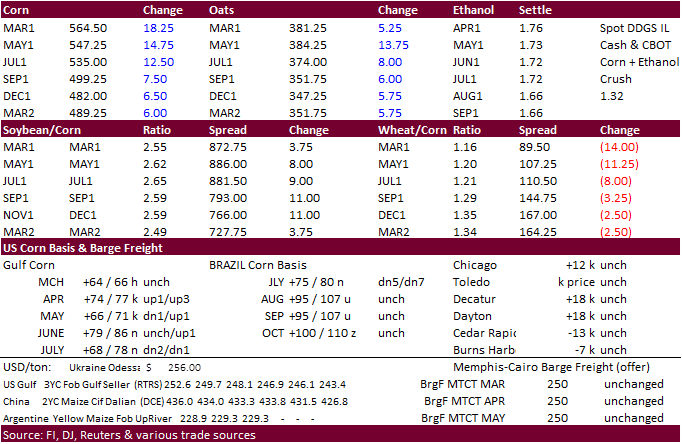
Updated
3/1/21
May
corn is seen in a $5.20 and $5.75 range.
July
is seen in a $5.00 and $6.00 range.
December
corn is seen in a $3.85-$5.50 range.
- Soybeans
traded higher in part to a dry outlook for Argentina and too much rain for parts of Brazil (raising concerns over quality) but a higher USD and Brazilian soybean shipments increasing over the next few weeks limited gains. Anec sees Brazil soybean exports
during March at 13.79 million tons. - May
soybeans has seen about a 13.40 to 14.45 trading range since late January. There is a potential for the contract to make a new high if SA weather fails to improve.
- We
are hearing US soybeans are starting to get tight in the ECB but WCB buyers are still able to source them.
- CBOT
soybean meal traded two-sided, ended higher. Strong corn prices and sharply higher soybeans supported meal. Soybean meal prices in China are starting to get cheap enough to entice an increase for feed use but importers may want to see better returns on crush
margins before setting off another round of soybean purchasing. - Soybean
oil had another 100+ point rally on ongoing concerns global vegetable oil supplies will continue to tighten.
- ICE
canola, May position, was up 3.10 as of to 785.40. Futures were up 6 straight sessions.
- The
SA weather forecast was unchanged Friday morning. Brazil rains will occur across the east central and northern areas through Tuesday while east central and northwest areas will see ongoing delays in fieldwork. Argentina rains, although light, should favor
southern Cordoba, northern La Pampa, and northwestern Buenos Aires on Monday.
- US
Census reported US January soybean exports at 324 million bushels, as expected, down from 397 million in December and 195 million during January 2020.
- The
funds were net buyers 15,000 soybean contracts, buyers of 2,000 soybean meal contracts and net buyers of 6,000 bean oil contracts. - Egypt
said they have enough vegetable oil strategic reserves for five months. - Indonesia
today will see heavy rain for parts of Indonesia’s Sumatra, Java, Kalimantan and Sulawesi.
- Offshore
values are leading soybean oil 83 lower (25 lower week to date) and SBM CBOT futures $1.80 lower ($7.00 lower for the week). - China
cash crush margins on our analysis were 101 cents, down from 112 cents late last week. China soybean meal prices fell to their lowest levels this year in China.
Export
Developments
- None
reported

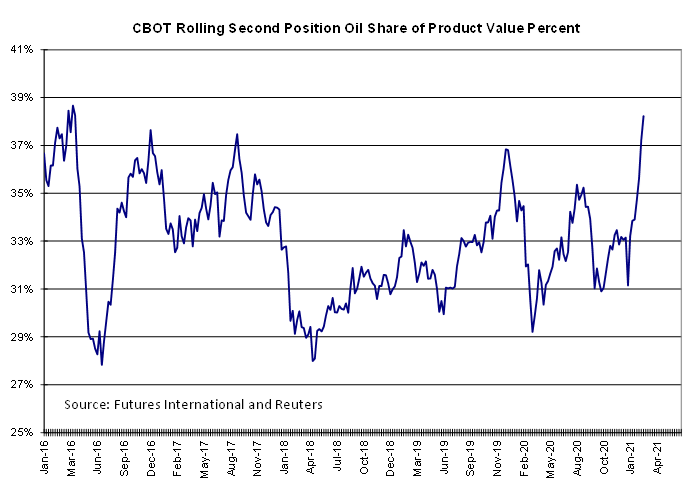
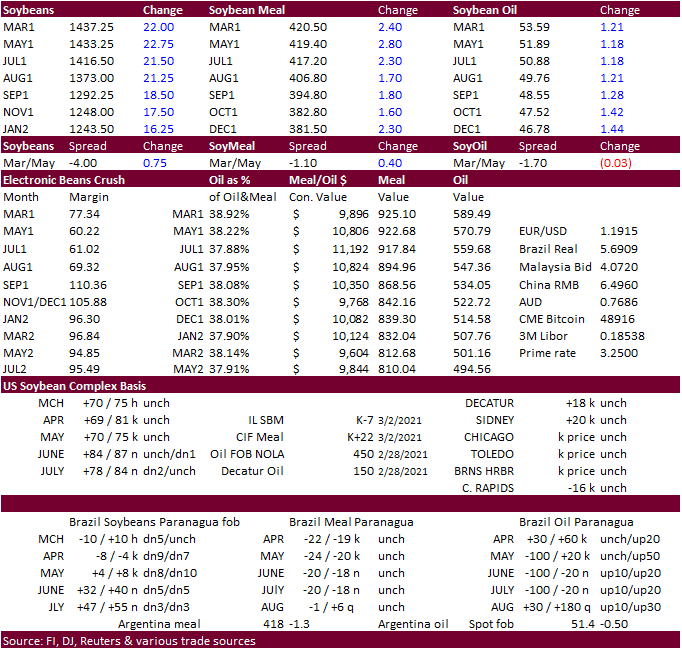
Updated
3/4/21
May
soybeans are seen in a $13.50 and $15.00 range.
May
soymeal is seen in a $400 and $460 range.
May
soybean oil is seen in a 49.00 and 54.00 cent range.
- Wheat
futures started
lower but turned higher following strength in corn and soybeans and higher outside markets, despite a higher USD and Pakistan passing on 300,000 tons of wheat due to high prices. The Philippines bought less than expected wheat, but SK picked up a couple cargoes
of opt. origin wheat. - The
USD was up 35 points by Friday afternoon. - Funds
were net buyers of 4,000 net soft wheat contracts on the session. - Black
Sea trades were quiet towards the end of this week as producers start to shift focus on new crop. The inverse in Paris wheat is also keeping some traders away.
- Ukraine
producers are expected to kick off the spring planting season next week, a little later than last year because of snow coverage.
- Over
in France barley plantings reached 50 percent as of March 11, up from 19 percent week earlier. French soft wheat was rated 88 percent good/excellent, up one point from previous week.
- French
wheat shipments outside EU and Britain: 821,000 tons in February, up from 561,000 tons in January and below the season high of 877,000 tons in November.
- EU
May milling wheat was up 0.25 at 208.75 euros.
Export
Developments.
- South
Korea’s MFG bought 130,000 tons of feed wheat, optional origin. Both 65,000 ton consignments were bought at an estimated $282.86 a ton c&f for arrival in South Korea around Aug. 24 and at $275.14 a ton c&f for arrival in South Korea around Sept. 24. (Reuters) - The
Philippines bought about 55,000 tons (145,000 sought) of milling wheat for April and June shipment. No prices were given but traders thought it was below $310/ton.
- Pakistan
may have passed on 300,000 tons of wheat due to high prices. - Results
awaited: Saudi Arabia seeks 540,000 tons of barley on Friday, valid until Monday, for April – May shipment.
- Results
awaited: Iran’s SLAL seeks up to 400,000 tons of animal feed barley on Wednesday, March 3, for shipment between March 10 and April 10.
Rice/Other
·
South Korea’s Agro-Fisheries & Food Trade Corp. seeks 38,889 tons of rice from the United States and China, part arrival in South Korea around Sept. 30 from the US. Another 16,667 tons of non-glutinous
short grain brown rice from China is sought for arrival around June 30.
·
Syria seeks 25,000 tons of white rice on March 29, from China or Egypt.

Updated
3/4/21
May
Chicago wheat is seen in a $6.25‐$6.90 range.
May
KC wheat is seen in a $5.50‐$6.75 range.
May
MN wheat is seen in a $6.20‐$6.65 range.
Terry Reilly
Senior Commodity Analyst – Grain and Oilseeds
Futures International
One Lincoln Center
18 W 140 Butterfield Rd.
Oakbrook Terrace, Il. 60181
W: 312.604.1366
ICE IM:
treilly1
Skype: fi.treilly

Trading of futures, options, swaps and other derivatives is risky and is not suitable for all persons. All of these investment products are leveraged, and you can lose more than your initial deposit. Each investment product is offered
only to and from jurisdictions where solicitation and sale are lawful, and in accordance with applicable laws and regulations in such jurisdiction. The information provided here should not be relied upon as a substitute for independent research before making
your investment decisions. Futures International, LLC is merely providing this information for your general information and the information does not take into account any particular individual’s investment objectives, financial situation, or needs. All investors
should obtain advice based on their unique situation before making any investment decision. The contents of this communication and any attachments are for informational purposes only and under no circumstances should they be construed as an offer to buy or
sell, or a solicitation to buy or sell any future, option, swap or other derivative. The sources for the information and any opinions in this communication are believed to be reliable, but Futures International, LLC does not warrant or guarantee the accuracy
of such information or opinions. Futures International, LLC and its principals and employees may take positions different from any positions described in this communication. Past results are not necessarily indicative of future results.

